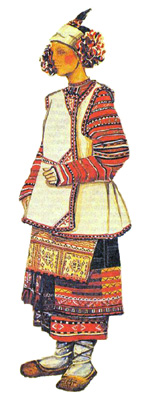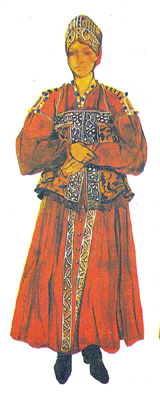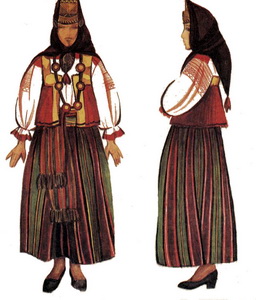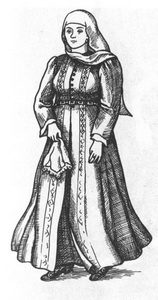Outfits >>>
Read about… >>>
Four Main Types
of Russian Women's Clothes.
An Overview. |
|
Scientists divide traditional Russian costume into four types. Those types differ from each over significantly by:
- quantity and design of items included
- the time period of occurrence
- the region of Russia where they were worn
|
1. A poneva-type.
This is the most ancient Russian and Slavic style of clothing. Pictures of poneva appeare in Russian manuscripts of the 10th century. At that time the word "poneva" meant a blanket. They began to use this word for a part of a costume in the 1400s. From the beginning of the 14th century, a poneva started to be gradually displaced by a sarafan-style outfit (see below). In the 17th century a poneva-style costume existed in the Southern Russia only. Moreover, in 1880s a poneva became an everyday clothes just for married peasant women, whereas young girls wore it just for one day for the "Jumping into the skirt" ritual (as a symbol of maturity).
A poneva-type outfit includes: a shirt (under-dress) with triangular or rectangular paliki (shoulder details), a poneva itself, an apron, nagrudnik (a kind of a jacket made of cotton or hemp), soroka-headdress for married women (or a decorated band around a forehead for unmarried girls), a waistband, shoes. |
 |
 |
2. A Sarafan-type.
A sarafan came to North-Western Russia in the 14th century as a men's outfit (it was a sort of a coat). It became a women's dress not earlier than 1500s-1600s. People rarely used the word sarafan. They preferred more descriptive titles, that pointed to a material a sarafan was made of (atlasnik - made of silk), or to a certain design's features (klinnik - consists of triangles), or to a region where that sarafan was worn (moskovik - from Moscow). From Northern Russia a sarafan spread among people to Siberia, and Baykal Lake region. In 1700s- 1800s a sarafan became not just village outfit, but a clothes of middle-class urban women, and merchants's wives. In Southern Russia of the 18th-19th centuries, a sarafan was a costume of young unmarried girls (in contrast to a poneva, which became a mark of marriage).
A sarafan-type outfit includes: a shirt with rectangular paliki (shoulder details), a sarafan itself, a dushegrea (a kind of a short sarafan-like warm jacket), kokoshnik-headdress for married women (a venec ("a diadem") for unmarried girls), a waistband, shoes. |
 |
3. An andarak-type.
This type was much more local than previous two. It was an outfit of odnodvorcy ("people of the same household"). They were descendants of Lithuanian soldiers served in Russian army in 1700s-1800s in Southern Russia. An andarak is a striped or checkered skirt of a mid-shank- or an ankle-length. It was worn in some villages of Ryazan, Tambov, Kursk, Orel, and Smolensk regions.
An andarak-type outfit consists of: a shirt with rectangular paliki (shoulder details) and a wide collar, an andarak itself, a vest, a Lithuanian-style headdress, a wide colorful waistband, shoes. |
|
4. A kubilek-type.
This style of clothes existed among cossacs in two small regions only: Don river basin (Southern Russia, now Ukraine) and Terek river basin (Northern Caucasus mountains). We don't know why scientists count it as a type (for us, the area of existence of this costume was too small). There is a hypothesis that a kubilek-dress was incorporated into cossacs' culture from Northern Caucasus highlanders' clothing style in the 17th century.
A kubilek is a long tight dress with long sleeves. Women wore it with a metal belt, a shirt, long pants, a knitted cap, and a silken veil on top of a cap. |
 |
|
|
Sources (in Russian)
- I.Shangina "Russian Traditional Everyday Life" (encyclopedia)
- N.Sosnina, I.Shangina, "Russian Traditional Costume" (a directory)
- M.M.Gromyko, "Everyday Behaviour of Russian Village in the 19th century"
- D.K.Zelenin, "Ethnography of Eastern Slavs"
- F.M.Parmon, "Traditional Russian Costume as a Source of Ideas"
|
|

